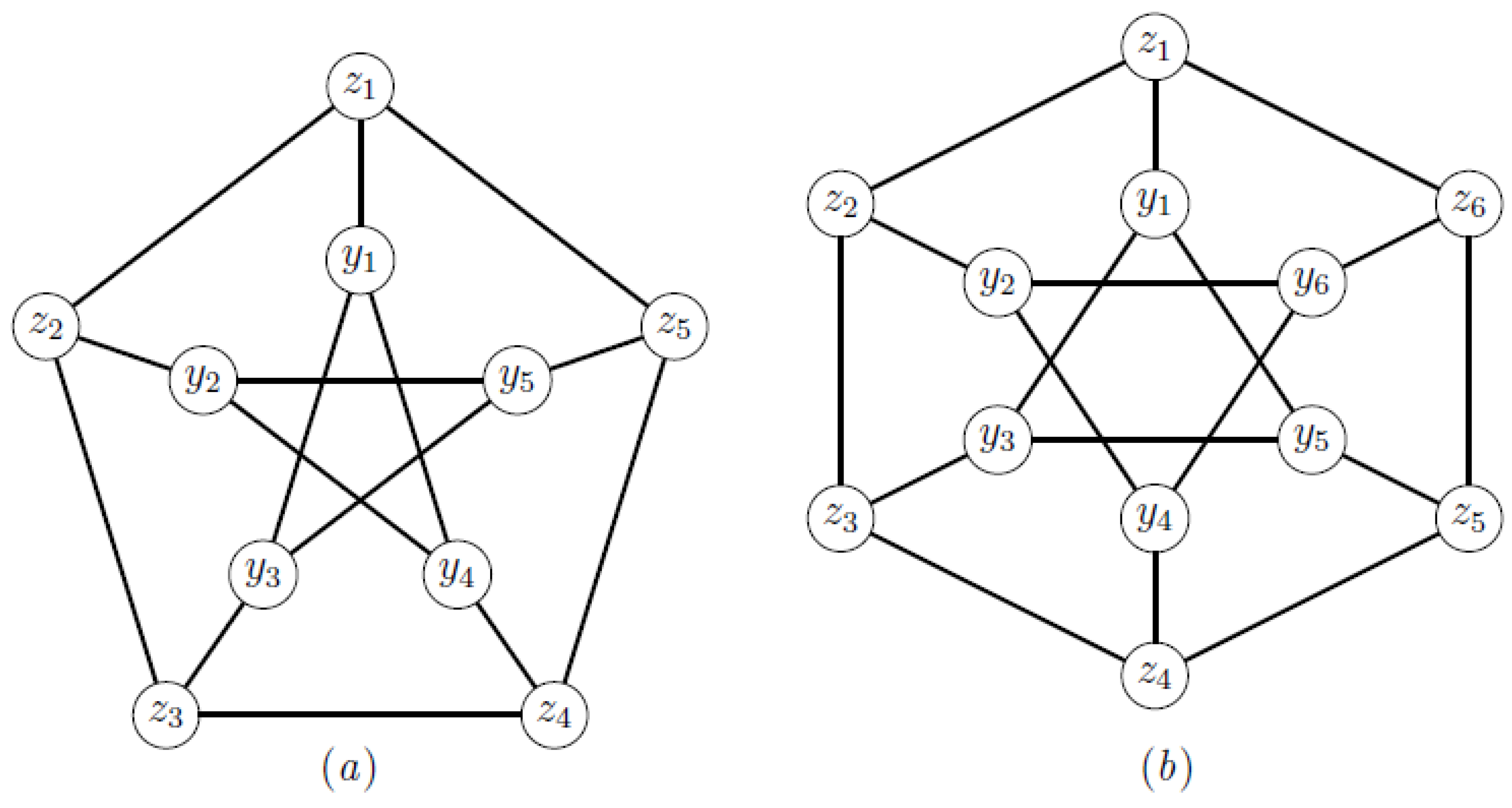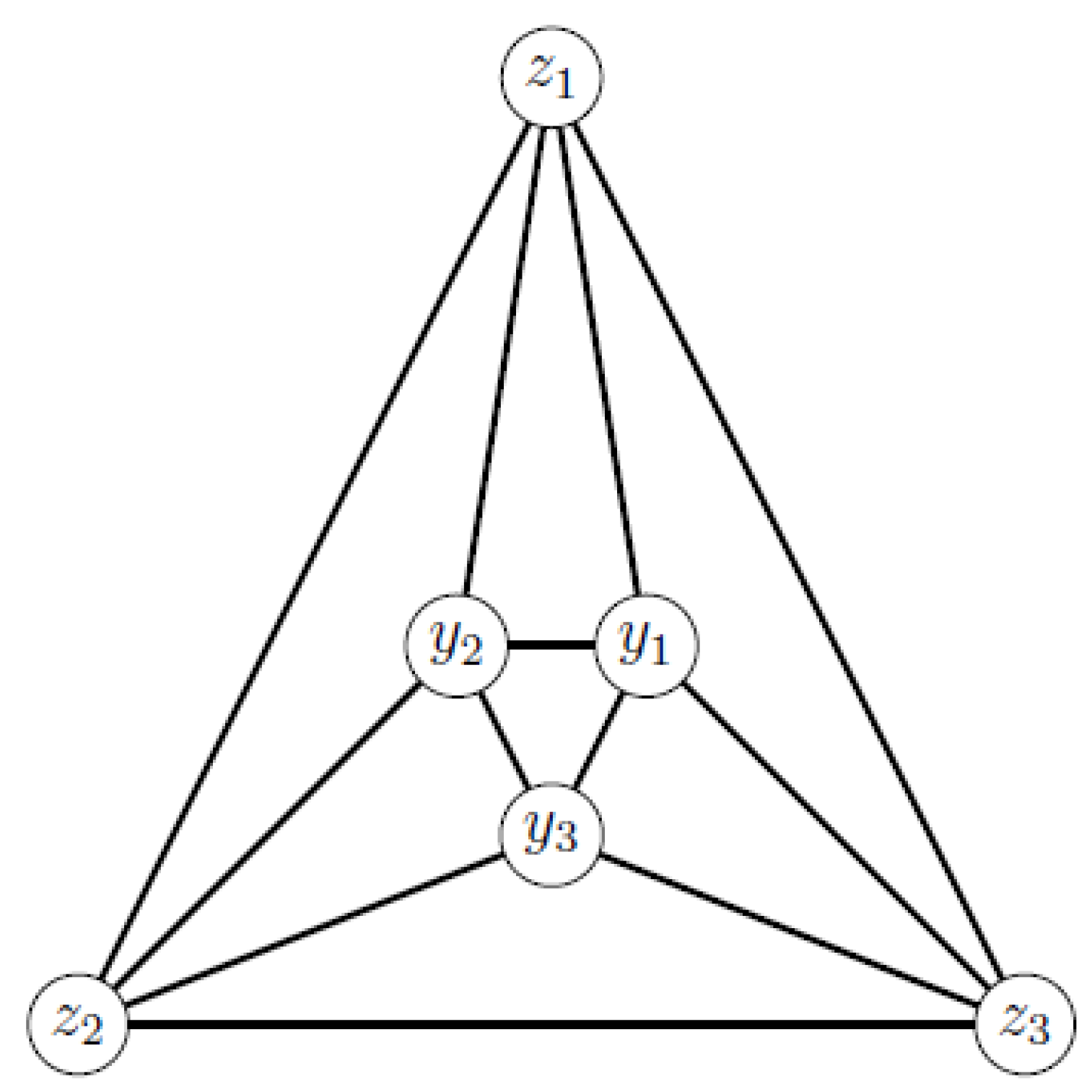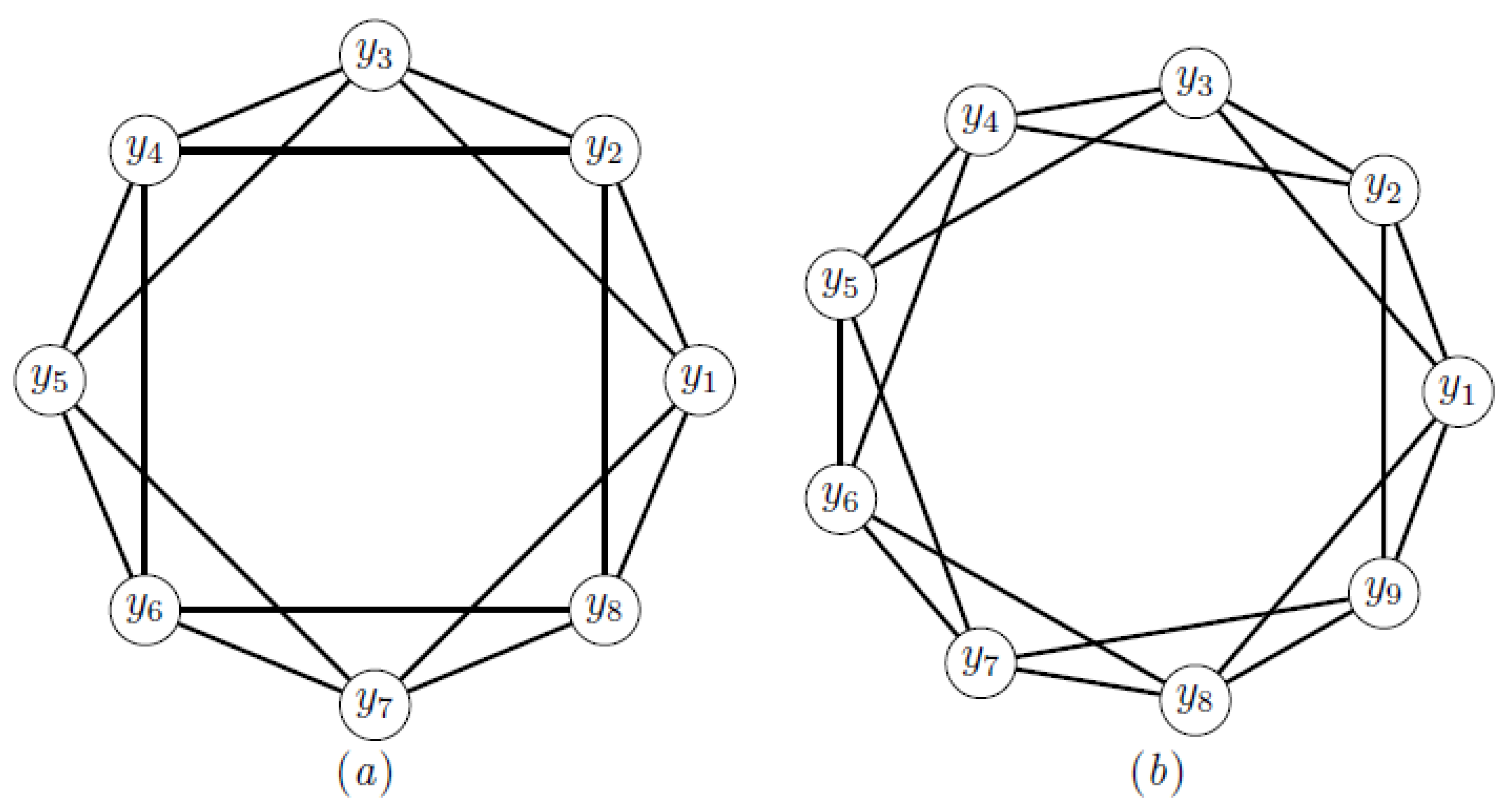Fault-Tolerant Resolvability and Extremal Structures of Graphs
Abstract
:1. Introduction
2. Preliminaries
3. Main Results
3.1. Some Characterizations
3.2. Relation between Resolving Sets and Fault-Tolerant Resolving Sets of Graphs
3.3. Extended Petersen Graphs
3.4. Anti-Prism Graphs
3.5. Squared Cycle Graphs
4. Concluding Remarks
- (i)
- Characterize n-ordered graphs with fault-tolerant metric dimension 3.
- (ii)
- Characterize n-ordered graphs with fault-tolerant metric dimension .
- (i)
- Study the fault-tolerant metric dimension of other interesting families of the regular graph, such as the prism graphs, and the generalized Petersen graphs , .
- (ii)
- Investigate the fault-tolerant metric dimension of strongly regular graphs, such as the square grid graphs and the triangular graphs.
- (iii)
- In view of Raza et al. [36], study the fault-tolerant resolvability in other direct and multiplex interconnection networks, such as the butterfly and Benes networks.
- (iv)
Author Contributions
Funding
Acknowledgments
Conflicts of Interest
References
- Slater, P.J. Leaves of trees. Proceedings of the 6th Southeastern Conference on Combinatorics, Graph Theory, and Computing. Congr. Numer. 1975, 14, 549–559. [Google Scholar]
- Harary, F.; Melter, R.A. On the metric dimension of a graph. Ars Comb. 1976, 2, 191–195. [Google Scholar]
- Khuller, S.; Raghavachari, B.; Rosenfeld, A. Landmarks in graphs. Discret. Appl. Math. 1996, 70, 217–229. [Google Scholar] [CrossRef] [Green Version]
- Liu, K.; Abu-Ghazaleh, N. Virtual coordinate back tracking for void travarsal in geographic routing. Lect. Notes Comput. Sci. 2006, 4104, 46–59. [Google Scholar]
- Beerloiva, Z.; Eberhard, F.; Erlebach, T.; Hall, A.; Hoffmann, M.; Mihalák, M.; Ram, L. Network discovery and verification. IEEEE J. Sel. Area Commun. 2006, 24, 2168–2181. [Google Scholar] [CrossRef]
- Chartrand, G.; Eroh, L.; Johnson, M.A.; Oellermann, O.R. Resolvability in graphs and the metric dimension of a graph. Discret. Appl. Math. 2000, 150, 99–113. [Google Scholar] [CrossRef]
- Bailey, R.F.; Meagher, K. On the metric dimension of Grassmann graphs. Discret. Math. Theor. Comput. Sci. 2011, 13, 97–104. [Google Scholar]
- Bailey, R.F.; Cameron, P.J. Basie size, metric dimension and other invariants of groups and graphs. Bull. Lond. Math. Soc. 2011, 43, 209–242. [Google Scholar] [CrossRef]
- Fehr, M.; Gosselin, S.; Oellermann, O. The metric dimension of Cayley digraphs. Discret. Math. 2006, 306, 31–41. [Google Scholar] [CrossRef] [Green Version]
- Ahmad, A.; Imran, M.; Al-Mushayt, O.; Bokhary, S.A.U.H. On the metric dimension of barycentric subdividion of Cayley graph Cay(Zn⊕Zm). Miskolc Math. Notes 2015, 16, 637–646. [Google Scholar]
- Cáceres, J.; Hernando, C.; Mora, M.; Pelayoe, I.M.; Puertas, M.L.; Seara, C.; Wood, D.R. On the metric dimension of cartesian products of graphs. SIAM J. Discret. Math. 2007, 21, 423–441. [Google Scholar] [CrossRef]
- Vetrík, T.; Ahmad, A. Computing the metric dimension of the categorial product of some graphs. Int. J. Comput. Math. 2015, 94, 363–371. [Google Scholar] [CrossRef]
- Siddiqui, H.M.A.; Imran, M. Computing the metric dimension of wheel related graphs. Appl. Math. Comput. 2014, 242, 624–632. [Google Scholar]
- Kratica, J.; Kovačević-Vujčić, V.; Čangalović, M.; Stojanović, M. Minimal doubly resolving sets and the strong metric dimension of some convex polytopes. Appl. Math. Comput. 2012, 218, 9790–9801. [Google Scholar] [CrossRef]
- Imran, M.; Siddiqui, H.M.A. Computing the metric dimension of conves polytopes generated by the wheel related graphs. Acta Math. Hung. 2016, 149, 10–30. [Google Scholar] [CrossRef]
- Cáceres, J.; Hernando, C.; Mora, M.; Pelayoe, I.M.; Puertas, M.L. On the metric dimension of infinite graphs. Electron. Notes Discret. Math. 2009, 35, 15–20. [Google Scholar] [CrossRef]
- Garey, M.R.; Johnson, D.S. Computers and Intractability: A Guide to the Theory of NP–Completeness; W.H. Freeman and Company: New York, NY, USA, 1979. [Google Scholar]
- Hernando, C.; Mora, M.; Slater, P.J.; Wood, D.R. Fault-tolerant metric dimension of graphs. In Proceedings International Conference on Convexity in Discrete Structures; Ramanujan Mathematical Society Lecture Notes; Ramanujan Mathematical Society: Tiruchirappalli, India, 2008; pp. 81–85. [Google Scholar]
- Chartrand, G.; Zhang, P. The theory and applications of resolvability in graphs: A survey. Congr. Numer. 2003, 160, 47–68. [Google Scholar]
- Krishnan, S.; Rajan, B. Fault-tolerant resolvability of certain crystal structures. Appl. Math. 2016, 7, 599–604. [Google Scholar] [CrossRef]
- Raza, H.; Hayat, S.; Pan, X.-F. On the fault-tolerant metric dimension of convex polytopes. Appl. Math. Comput. 2018, 339, 172–185. [Google Scholar] [CrossRef]
- Raza, H.; Hayat, S.; Pan, X.-F. Binary locating-dominating sets in rotationally-symmetric convex polytopes. Symmetry 2018, 10, 727. [Google Scholar] [CrossRef]
- Salman, M.; Javaid, I.; Chaudhry, M.A. Minimum fault-tolerant, local and strong metric dimension of graphs. arXiv, 2014; arXiv:1409.2695. [Google Scholar]
- Hayat, S. Computing distance-based topological descriptors of complex chemical networks: New theoretical techniques. Chem. Phys. Lett. 2017, 688, 51–58. [Google Scholar] [CrossRef]
- Hayat, S.; Imran, M. Computation of topological indices of certain networks. Appl. Math. Comput. 2014, 240, 213–228. [Google Scholar] [CrossRef]
- Hayat, S.; Malik, M.A.; Imran, M. Computing topological indices of honeycomb derived networks. Rom. J. Inf. Sci. Technol. 2015, 18, 144–165. [Google Scholar]
- Hayat, S.; Wang, S.; Liu, J.-B. Valency-based topological descriptors of chemical networks and their applications. Appl. Math. Model. 2018, 60, 164–178. [Google Scholar] [CrossRef]
- Imran, M.; Hayat, S.; Malik, M.Y.H. On topological indices of certain interconnection networks. Appl. Math. Comput. 2014, 244, 936–951. [Google Scholar] [CrossRef]
- Bondy, J.A.; Murty, U.S.R. Graph Theory; Springer: New York, NY, USA, 2008. [Google Scholar]
- Shang, Y. Resilient consensus of switched multi-agent systems. Syst. Control Lett. 2018, 122, 12–18. [Google Scholar] [CrossRef]
- Shang, Y. Resilient multiscale coordination control against adversarial nodes. Energies 2018, 11, 1844. [Google Scholar] [CrossRef]
- Javaid, I.; Salman, M.; Chaudhry, M.A.; Shokat, S. Fault-tolerance in resolvibility. Util. Math. 2009, 80, 263–275. [Google Scholar]
- Watkins, M.E. A theorem on Tait colorings with an application to the generalized Petersen graphs. J. Comb. Theory 1969, 6, 152–164. [Google Scholar] [CrossRef]
- Javaid, I.; Rahim, T.; Ali, K. Families of regular graphs with constant metric dimension. Util. Math. 2008, 65, 21–33. [Google Scholar]
- Gallian, J.A. A dynamic survey of graph labeling. Electron. J. Comb. 2018, #DS6, 1–219. [Google Scholar] [PubMed]
- Raza, H.; Hayat, S.; Pan, X.-F. On the fault-tolerant metric dimension of certain interconnection networks. J. Appl. Math. Comput. 2018. [Google Scholar] [CrossRef]
- Chen, M.S.; Shin, K.G.; Kandlur, D.D. Addressing, routing and broadcasting in hexagonal mesh multiprocessors. IEEE Trans. Comput. 1990, 39, 10–18. [Google Scholar] [CrossRef]
- Wang, W.-H.; Palaniswami, M.; Low, H.L. Optimal flow control and routing in multi-path networks. Perform. Eval. 2003, 52, 119–132. [Google Scholar] [CrossRef]
- Shang, Y. Deffuant model of opinion formation in one-dimensional multiplex networks. J. Phys. A Math. Theor. 2015, 48, 395101. [Google Scholar] [CrossRef]
- Antonopoulos, C.G.; Shang, Y. Opinion formation in multiplex networks with general initial distributions. Sci. Rep. 2018, 8, 2852. [Google Scholar] [CrossRef]





© 2019 by the authors. Licensee MDPI, Basel, Switzerland. This article is an open access article distributed under the terms and conditions of the Creative Commons Attribution (CC BY) license (http://creativecommons.org/licenses/by/4.0/).
Share and Cite
Raza, H.; Hayat, S.; Imran, M.; Pan, X.-F. Fault-Tolerant Resolvability and Extremal Structures of Graphs. Mathematics 2019, 7, 78. https://doi.org/10.3390/math7010078
Raza H, Hayat S, Imran M, Pan X-F. Fault-Tolerant Resolvability and Extremal Structures of Graphs. Mathematics. 2019; 7(1):78. https://doi.org/10.3390/math7010078
Chicago/Turabian StyleRaza, Hassan, Sakander Hayat, Muhammad Imran, and Xiang-Feng Pan. 2019. "Fault-Tolerant Resolvability and Extremal Structures of Graphs" Mathematics 7, no. 1: 78. https://doi.org/10.3390/math7010078




